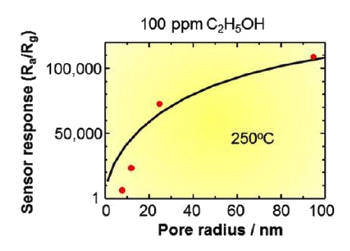VOC Detection with Nanocrystals
February 23, 2017
Modern
electronic sensors have easily duplicated the functions of the
human senses of
sight,
hearing, and
touch, but they have had a harder time with
taste and
smell (more properly termed,
olfaction).
Microwave-oven sized equipment such as
infrared spectrometers,
mass spectrometers, and
gas chromatographs are able to act somewhat as taste and smell sensors.
As I wrote in a
previous article (Breath Analysis, December 7, 2015), the human sense of smell is not that sensitive, and it's insensitive to certain
gases. Most important among these is the
poisonous gas,
carbon monoxide, that might accumulate in dwellings that use
combustion for
heating. While we might think that we can smell
natural gas, what we smell is actually
tert-Butylthiol (t-butyl mercaptan). As any
organic chemist will tell you,
mercaptans have a strong odor in even small quantities.
There's been some
research on "
electronic noses" for detection of particular gases, especially carbon monoxide and
flammable gases such as
hydrogen. Some odor sensors detect the
weight change of
adsorbed chemicals on an
analyte-covered
quartz crystal or
MEMS resonant cantilevers, but carbon monoxide and flammable gas sensors use a much simpler approach of changing
electrical conductivity in heated
tin dioxide (SnO
2, stannic oxide). A good
review of other oxides for gas sensing is found in ref. 1.[1]

Two styles of electronic noses: A resonant cantilever (left) can be used to detect weight change of adsorbed molecules, while a compressed powder of tin dioxide, when heated, (right) will change resistance when exposed to a reactive gas such as hydrogen because of changes in composition of the particle surface. The cantilever resonance frequency, Fr, depends on the beam thickness t, the beam length L, the Young's modulus E, and the material density ρ. The average density will change when odor molecules are adsorbed. Surprisingly, the width of the beam doesn't figure into the resonance formula. (Created using Inkscape.)
For the tin dioxide sensors, the material is heated to several hundred degrees
Celsius. As can be seen from the
graph, the
rate constant for the
decomposition of stannic oxide in the presence of hydrogen is quite large at these temperatures, so the conductivity of the oxide pellet changes greatly when hydrogen is present. When the hydrogen is removed,
oxygen from the
air reconstitutes the stannic oxide.

Rate constant of stannic oxide reduction by hydrogen.
At 650 K (375 °C), about one percent of SnO2 is reduced to Sn.
(Graphed with Gnumeric from a calculation using free energy data in ref. 2.)[2)]
When a
material works well in an application, there's a good chance that a
nanoscale version of the material might do a better job. That's what a team of
electrical engineers and
materials scientists from
Singapore and the
Xi'an Jiaotong University (China) did in 2005.[3] They used
plasma-enhanced chemical vapor deposition to create layers of SnO
2 that they subsequently processed to make into nanorods about 7
nanometers (nm) in
diameter and 100 nm in length. In this way, they were able to decrease the operating temperature for gas sensing by 80 °C and increase the
sensitivity by a factor of eight.[3]
A recent study by
scientists from
Kumamoto University (Kumamoto, Japan), the
Fukuoka Industrial Technology Center (Fukuoka, Japan), and
Tohoku University (Sendai, Japan) looked at nanocube and nanorod sensors of SnO
2 as detectors of
volatile organic compounds (VOCs), which are
carbon-based chemicals with low
evaporation or
vaporization temperatures, at very low
concentrations.[4-5]
The nanocubes, 13 nm on a side, and the nanorods of rod lengths from 50-500 nm were
synthesized using the
hydrothermal method of
crystal growth in which
organic precursors were
dissolved in an
acid.[4] Films of the nanocubes had small
pores, less than 10 nm, while the nanorod films had larger pores.
Palladium was incorporated into some films to see whether its addition would improve sensitivity.[4]
The films showed a resistance change for hydrogen concentrations of 200
ppm, with best sensitivity at 300 °C, and the hydrogen sensitivity decreased with increased
crystal size.[4] The films responded also to 100 ppm
ethanol and 100 ppm
acetone; but, in those cases, the sensitivity increased as crystal size and resultant pore size increased, with the highest sensitivity found for the longest nanorods.[4]
Best performance for VOCs was for 500 nm nanorods at a temperature of about 250 ° C, with palladium-doped films having better response.[5] Exposure to 100 ppm ethanol at 250 °C gave a resistance change of five
orders of magnitude (see figure).[4]

Tin dioxide nanocrystal sensor response to ethanol as a function of pore size.
There's a five orders of magnitude resistance change at 250 °C.
(Kumamoto University image by Tetsuya Kida.)
Says
Tetsuya Kida, a
professor at Kumamoto University and an
author of the study,
"Our experiments show that nanocrystal sensors with larger pore sizes gave the best sensor responses. In particular, we found ultra-high sensitivity (increasing by five orders of magnitude) in the devices with largest pore size, the long nanorod sensors... This tells us that is beneficial to have precise control over the manufacturing methods of these types of sensors."[5]
Sensing of VOCs is important, since they are an
environmental health hazard. Their detection can be used in
medical diagnostics, since several VOCs are known
biomarkers for
glucose malabsorption,
alcohol intoxication, and
diabetic ketoacidosis.[5] These sensors have capability for
alcohol breathalyzer use for alcohol detection at the lower
parts-per-billion level.[5]
One problem of these SnO
2 VOCs sensors is their long recovery time. While they respond to gases within 15-21 seconds, when the gases are removed, they don't return to their normal state for several hours.[5] This appears to be a consequence of
reaction residues remaining on the surface. Furthermore, the ethanol sensors
saturate when the pore size is greater than 80 nm.[5] However, there are many processing variations to explore to mitigate such effects.
References:
- Chengxiang Wang, Longwei Yin, Luyuan Zhang, Dong Xiang, and Rui Gao, "Metal Oxide Gas Sensors: Sensitivity and Influencing Factors," Sensors, vol. 10, no. 3 (March 15, 2010), pp. 2088-2106, doi:10.3390/s100302088. This is an open access article with a PDF file available here.
- C. E. Wicks and F. E. Block, "Thermodynamic Properties of 65 Elements - Their Oxides, Halides, Carbides, and Nitrides," U. S. Bureau of Mines Bulletin 605, U. S. Government Printing Office (1963).
- Hui Huang, O. K. Tan, Y. C. Lee, T. D. Tran, and M. S. Tse X. Yao, "Semiconductor gas sensor based on tin oxide nanorods prepared by plasma-enhanced chemical vapor deposition with postplasma treatment," Applied Physics Letters, vol. 87, no. 16 (October, 2005), DOI: http://dx.doi.org/10.1063/1.2106006.
- Tetsuya Kida, Koichi Suematsu, Kazuyoshi Hara, Kiyoshi Kanie, and Atsushi Muramatsu, "Ultrasensitive Detection of Volatile Organic Compounds by a Pore Tuning Approach Using Anisotropically Shaped SnO2 Nanocrystals," ACS Appl. Mater. Interfaces, vol. 8, no. 51 (November 30, 2016), pp. 35485-35495, DOI: 10.1021/acsami.6b13006.
- Highly sensitive gas sensors for volatile organic compound detection, Kumamoto University Press Release, February 1, 2017.
Permanent Link to this article
Linked Keywords: Electronic; sensor; human sense; sight; hearing; touch; taste; smell; olfaction; microwave oven; infrared spectroscopy; infrared spectrometer; mass spectrometry; mass spectrometer; gas chromatograph; gas; poison; poisonous; carbon monoxide; combustion; central heating; natural gas; tert-Butylthiol (t-butyl mercaptan); organic chemistry; organic chemist; thiol; mercaptan; research; electronic nose; flammability; flammable; hydrogen; mass; weight; adsorption; adsorb; chemical compound; analyte; quartz crystal; microelectromechanical system; MEMS; resonance; resonant; cantilever; electrical conductivity; tin dioxide; review article; molecule; compression; compressed; powder; resistance; chemical reaction; reactive; chemical decomposition; change in composition; frequency; Young's modulus; density; Inkscape; Celsius; Cartesian coordinate system; graph; reaction rate constant; oxygen; atmosphere of Earth; air; stannic oxide; redox; reduction; tin; Sn; Gnumeric; material; nanoscopic scale; nanoscale; electrical engineering; electrical engineer; materials science; materials scientist; Singapore; Xi'an Jiaotong University (China); plasma-enhanced chemical vapor deposition; nanometer; diameter; sensitivity; scientist; Kumamoto University (Kumamoto, Japan); Fukuoka Industrial Technology Center (Fukuoka, Japan); Tohoku University (Sendai, Japan); volatile organic compound; organic compound; carbon-based chemical; evaporation; vaporization; concentration; chemical synthesis; synthesize; hydrothermal synthesis; hydrothermal method; crystal growth; organic compound; precursor; dissolution; dissolve; acid; porosity; pore; palladium; parts-per notation; ppm; crystal; ethanol; acetone; order of magnitude; nanocrystal; sensor; pore size; Tetsuya Kida; professor; author; experiment; manufacturing; environment; health; hazard; medical diagnosis; medical diagnostic; biomarker; glucose; malabsorption; alcohol intoxication; diabetic ketoacidosis; alcohol breathalyzer; parts-per-billion; reaction residue; saturation.